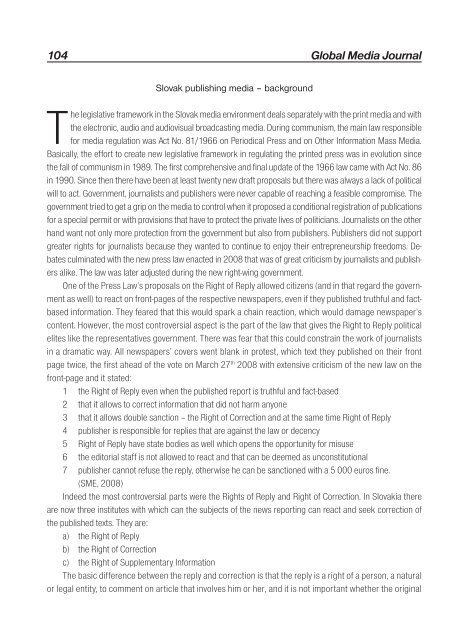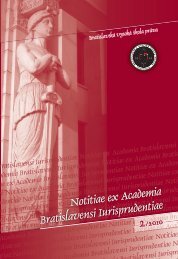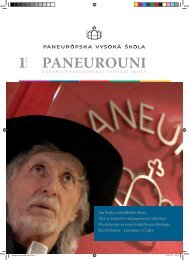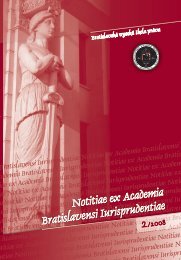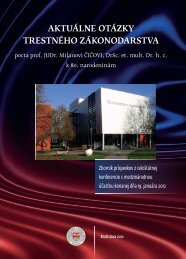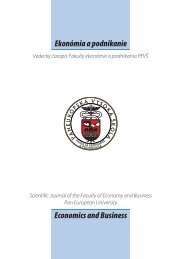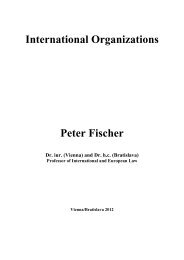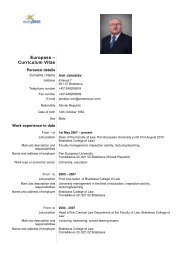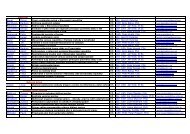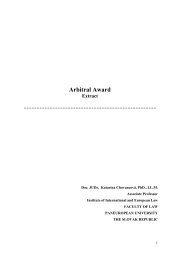ÄÃslo 1/2013 - Paneurópska vysoká Å¡kola
ÄÃslo 1/2013 - Paneurópska vysoká Å¡kola
ÄÃslo 1/2013 - Paneurópska vysoká Å¡kola
Create successful ePaper yourself
Turn your PDF publications into a flip-book with our unique Google optimized e-Paper software.
104<br />
Global Media Journal<br />
Slovak publishing media – background<br />
The legislative framework in the Slovak media environment deals separately with the print media and with<br />
the electronic, audio and audiovisual broadcasting media. During communism, the main law responsible<br />
for media regulation was Act No. 81/1966 on Periodical Press and on Other Information Mass Media.<br />
Basically, the effort to create new legislative framework in regulating the printed press was in evolution since<br />
the fall of communism in 1989. The first comprehensive and final update of the 1966 law came with Act No. 86<br />
in 1990. Since then there have been at least twenty new draft proposals but there was always a lack of political<br />
will to act. Government, journalists and publishers were never capable of reaching a feasible compromise. The<br />
government tried to get a grip on the media to control when it proposed a conditional registration of publications<br />
for a special permit or with provisions that have to protect the private lives of politicians. Journalists on the other<br />
hand want not only more protection from the government but also from publishers. Publishers did not support<br />
greater rights for journalists because they wanted to continue to enjoy their entrepreneurship freedoms. Debates<br />
culminated with the new press law enacted in 2008 that was of great criticism by journalists and publishers<br />
alike. The law was later adjusted during the new right-wing government.<br />
One of the Press Law’s proposals on the Right of Reply allowed citizens (and in that regard the government<br />
as well) to react on front-pages of the respective newspapers, even if they published truthful and factbased<br />
information. They feared that this would spark a chain reaction, which would damage newspaper’s<br />
content. However, the most controversial aspect is the part of the law that gives the Right to Reply political<br />
elites like the representatives government. There was fear that this could constrain the work of journalists<br />
in a dramatic way. All newspapers’ covers went blank in protest, which text they published on their front<br />
page twice, the first ahead of the vote on March 27 th 2008 with extensive criticism of the new law on the<br />
front-page and it stated:<br />
1 the Right of Reply even when the published report is truthful and fact-based<br />
2 that it allows to correct information that did not harm anyone<br />
3 that it allows double sanction – the Right of Correction and at the same time Right of Reply<br />
4 publisher is responsible for replies that are against the law or decency<br />
5 Right of Reply have state bodies as well which opens the opportunity for misuse<br />
6 the editorial staff is not allowed to react and that can be deemed as unconstitutional<br />
7 publisher cannot refuse the reply, otherwise he can be sanctioned with a 5 000 euros fine.<br />
(SME, 2008)<br />
Indeed the most controversial parts were the Rights of Reply and Right of Correction. In Slovakia there<br />
are now three institutes with which can the subjects of the news reporting can react and seek correction of<br />
the published texts. They are:<br />
a) the Right of Reply<br />
b) the Right of Correction<br />
c) the Right of Supplementary Information<br />
The basic difference between the reply and correction is that the reply is a right of a person, a natural<br />
or legal entity, to comment on article that involves him or her, and it is not important whether the original<br />
GMJ Book.indb 104 21.1.<strong>2013</strong> 9:44


